Sustainability is becoming an essential part of modern business operations, and one often-overlooked area for improvement is office printing. Many offices continue to use large amounts of paper and ink unnecessarily, leading to excessive waste and increased costs. However, by adopting eco-friendly printing practices, businesses can significantly reduce their environmental impact while also saving money. Here’s how your office can implement greener printing strategies.

Choose Eco-Friendly Printers and Optimize Settings
Investing in energy-efficient office equipment can make a significant impact on sustainability efforts. When selecting a printer, businesses should look for Energy Star-certified models, which consume less power and automatically switch to low-energy mode when not in use. These energy-efficient devices help reduce electricity costs while also lowering carbon emissions.
Optimizing printer settings is another simple way to cut down on waste. By setting all office printers to default to double-sided printing, businesses can immediately reduce their paper usage by half. Additionally, enabling toner-saving or draft mode for internal documents can extend the life of printer cartridges and lower ink consumption. These small adjustments can lead to substantial savings over time while also minimizing environmental impact.
Use Recycled and Sustainable Paper

The type of paper an office uses plays an important role in sustainability efforts. Instead of relying on traditional paper, companies can switch to recycled paper made from post-consumer materials. This choice reduces the demand for virgin paper, helping to preserve forests and decrease energy consumption associated with paper production.
Another sustainable option is Forest Stewardship Council (FSC)-certified paper, which ensures that the paper is sourced from responsibly managed forests. Businesses that prioritize FSC-certified products contribute to global efforts to maintain healthy and sustainable forest ecosystems.
Proper paper management is also essential in reducing waste. Keeping paper stored in a cool, dry place prevents curling and jamming, which can lead to wasted prints. Encouraging employees to be mindful of their paper use and only print when necessary can also help minimize overall consumption.
Recycle and Reuse Printer Supplies

Printer supplies, such as ink and toner cartridges, often end up in landfills, but they don’t have to. Many manufacturers and office supply stores offer recycling programs that allow businesses to return used cartridges for proper disposal or refurbishment. Participating in these programs helps reduce waste while also promoting responsible recycling practices.
Another cost-effective and environmentally friendly alternative is the use of refillable or remanufactured ink and toner cartridges. These options provide the same high-quality performance as new cartridges while reducing the demand for new plastic and other materials. By making the switch to remanufactured cartridges, businesses can lower costs and decrease their environmental footprint.
Paper waste can also be minimized by repurposing scrap paper. Instead of discarding misprints or outdated documents, employees can use the blank side of printed sheets for notes or drafts. This simple habit can significantly reduce the amount of paper that gets thrown away.
Optimize Print Management to Reduce Unnecessary Printing
Controlling how printing is managed in an office can lead to significant reductions in waste and cost. Many businesses are implementing print tracking software to monitor employee printing habits. These tools help identify areas where print use can be reduced and allow businesses to set limits on unnecessary printing.
Another effective strategy is the use of secure printing features. By requiring employees to enter a passcode or use an ID card at the printer to release print jobs, companies can prevent abandoned printouts and reduce wasted paper. This feature ensures that only necessary documents are printed and collected.
Additionally, establishing clear office policies regarding printing can help create a culture of sustainability. Employees should be encouraged to only print when absolutely necessary and to use digital alternatives whenever possible. Providing training and guidelines on eco-friendly printing practices can reinforce these habits and lead to long-term savings.
Consider Leasing Instead of Buying Office Equipment
For businesses looking to further improve their sustainability efforts, leasing office equipment instead of purchasing it outright can be a practical solution. Leasing allows companies to always have access to the latest energy-efficient printing technology without the need for frequent upgrades or replacements. Since leasing providers often refurbish and reuse equipment, this approach also helps reduce electronic waste.
Another advantage of leasing is that it often includes maintenance services, ensuring that office equipment remains in top condition. Well-maintained printers operate more efficiently, use fewer resources, and last longer. This reduces both environmental impact and long-term costs for the business.
Saving Money While Protecting the Environment
By implementing eco-friendly printing practices, businesses can reduce waste, cut costs, and contribute to a healthier planet. Small changes, such as printing less, using sustainable supplies, and optimizing printer settings, can have a significant impact over time.
For companies looking to take their sustainability efforts a step further, leasing energy-efficient office equipment and participating in recycling programs can make an even greater difference. Investing in eco-friendly printing solutions not only benefits the environment but also enhances operational efficiency and lowers expenses.
If your business is ready to upgrade to more sustainable office equipment or needs help optimizing its printing practices, contact us today to learn more about our eco-friendly solutions.
📞 Call 281-879-8838
🔗 Contact us to learn more about our printing solutions!

